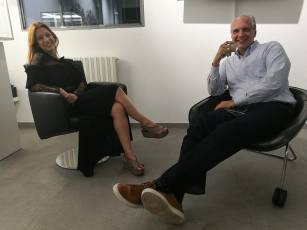After much success of merging computer graphics and software with microscopy, it’s not surprising to find Qi’s next step into the future of cancer research…Virtual Reality (VR) (duh!)
Naturally, our first act toward this high level and carefully planned enterprise would be the sole responsibility of Qi’s very first intern.
Meet Milo Szecket!
Qi’s VR Experience internship was created to provide a more immersive experience in analyzing tissue. We believe biologists can see more within a VR system than just looking at one screen. Milo was the perfect candidate that fit the youth, talent, and intelligence we were looking for to start this project.
Although originally from California, he would spend most of his childhood living in Pittsburgh, Pennsylvania and the rest of his high school education currently at Governor Thomas Johnson High School in Frederick, Maryland, as a senior.
…So, Milo, what’s your story?
Well, I’ve always been interested in my dad’s work as a computer graphics designer and when an opportunity arose for me to participate in it while still sort of “doing my own thing,” I took it.
Tell us about yourself and why the interest in VR?
The obvious answer is because VR is COOL! But more than that, I haven’t seen many tools being created in VR, except specific-to-VR stuff like vector field makers.
The closest to a full program meant to actually do something in VR I have found is Kanova, a sculpting program that Foundry (a leading developer of software for media entertainment and digital design) is testing that looks really great. I think VR has a lot more applications to explore, and Qi’s VR Experience of interacting with the cells inside cancer tissue is certainly an interesting one that I’m excited to be a part of.
What’s the last thing you really geeked out about?
To be honest, it would have to be either this or the my robotics team. We are FRC Team 686, if you’re interested. I do data collection and analysis during competitions.
What motivated you to choose QiTissue as your first VR experience?
It’s really the only chance I’ve had to work with VR, plus, come on. Photoshop for curing cancer? How cool is that?!
What would you like to accomplish on this project?
Ideally (and obviously) I want to end up with a usable VR interface for all aspects of QiTissue, even the 2D ones. More realistically, I’ll be learning Unity VR development for a while before we get to that.
What are your wins so far?
Well, I got Unity installed and running on the Vive, which was more of a feat than I’d like to admit. At this point, the furthest I’ve gotten is being able to pick up a specimen and turn it around and look at it. Currently, it’s still mostly setup, but I’ll be doing more very soon.
What are the challenges so far?
The first thing I wanted to accomplish is grabbing the specimen with both hands and resizing it. This has proven to be a bit of a pain, and by a bit of a pain, I mean no one that I can find has done it with the newest VR plugins for Unity. That will be the main challenge, I think. Unbelievable the lack of documentation for such a new technology.
Milo’s goals for Qi’s VR Experience will be to create a novel experience so people will like it and a new interactive and natural way to navigate a 3D landscape as opposed to a mouse, trackpad, or joystick.
Milo’s work will be the benchmark for our future endeavors to perfect this project. Look for more posts about his progress on Qi social media!











 The performance of processors and integrated circuits has improved so much and they have become so inexpensive that new technologies like machine learning and artificial intelligence are finding their way into an increasing number of applications. Because this opens up the possibility of totally new systems that perceive their environment autonomously, draw conclusions from it and then make decisions, it made sense to feature nanoQuill and QiTissue and their workflow and machine learning aspects that advance cancer research and accelerate our fight to end the disease.
The performance of processors and integrated circuits has improved so much and they have become so inexpensive that new technologies like machine learning and artificial intelligence are finding their way into an increasing number of applications. Because this opens up the possibility of totally new systems that perceive their environment autonomously, draw conclusions from it and then make decisions, it made sense to feature nanoQuill and QiTissue and their workflow and machine learning aspects that advance cancer research and accelerate our fight to end the disease.













 SIGGRAPHers also have the opportunity to upload and post their artwork for likes (using #color4cancer) AND showcase their nanoQ artistry on the nanoQuill website
SIGGRAPHers also have the opportunity to upload and post their artwork for likes (using #color4cancer) AND showcase their nanoQ artistry on the nanoQuill website 


